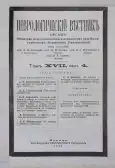Prof. P. V. Nikolsky. The effect of mental activity on the skin. Warsaw Univ. Izvestia 1910. VI
- Authors: Baklushinskiy I.D.
- Issue: Vol XVII, No 4 (1910)
- Pages: 866-866
- Section: Abstracts
- URL: https://journals.rcsi.science/1027-4898/article/view/104719
- DOI: https://doi.org/10.17816/nb104719
- ID: 104719
Cite item
Full Text
Abstract
Mental activity has a strong influence on the vital activity of the skin in two opposite directions: in the sense of weakening and strengthening it. This phenomenon is quite understandable if we take into account that the skin is genetically related to the nervous system (the cuticle and the nervous system develop from the same germ layer - ectoderm) and is abundantly supplied with a network of nerve fibers and nerve endings. Therefore, any spiritual movement (shame, grief, joy, etc.) is expressed by a change in the skin and its appendages: redness, blanching of it, sweating, and hair loss, their graying, etc. Under the influence of spiritual unrest, the appearance of many skin diseases: nervous itching, eczema, erythema, urticaria, psoriasis, etc. Similar changes in the skin occur under the influence of suggestion and self-hypnosis. A striking example of the latter is the so-called. stigmatized faces in the Catholic Church. In the same way, many authors have been able to get positive results from suggestion. Hence, according to the author, there is already one step towards the introduction of hypnosis into dermatotherapy: initial experiments in this direction have already been made with positive results (Hebold, Paul. Farez, Agadzhanyants).
Keywords
Full Text
##article.viewOnOriginalSite##About the authors
Ivan D. Baklushinskiy
Author for correspondence.
Email: info@eco-vector.com
Russian Federation
References
Supplementary files






